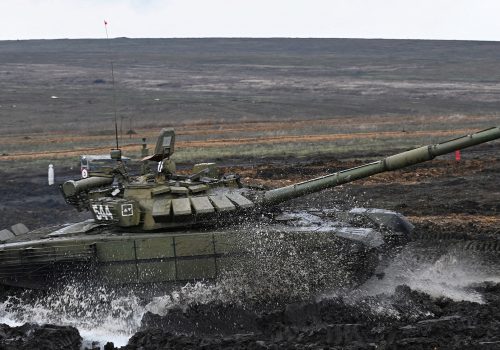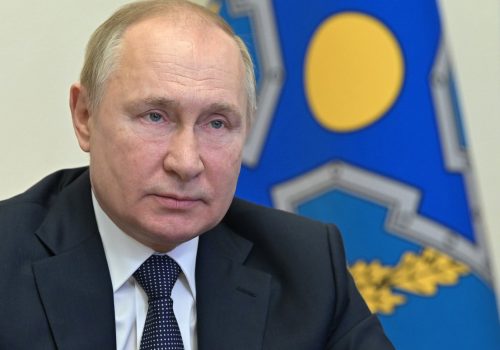What if Russia invades Ukraine (again)? Consider these options for sanctions escalation.
Editor’s note: This article was originally published in April 2021. It has been substantially updated as of January 21, 2022 to reflect the current state of play with Russia and present new sanctions options.
Just weeks into 2022—amid Western refusal to give into Kremlin demands for a sphere of domination in Central and Eastern Europe—intensified Russian attacks on Ukraine appear more likely than ever. Possibly coming at any time, according to the US government, these could include combinations of aggressive cyber or physical sabotage, assassinations, air and rocket assaults on Ukrainian military or civilian infrastructure, limited military incursions, or a full-scale land invasion.
In seeking to prevent this kind of escalation, the Biden administration has sought to rally NATO allies and Europe generally around a deterrence approach that includes continued diplomacy, military assistance to Kyiv, military reinforcement to NATO’s eastern flank members, and threats of substantially heavier sanctions than have been imposed on Russia since its 2014 invasion of Ukraine and annexation of Crimea.
We were involved in the design and negotiation of the first round of sanctions on Russia in 2014 while serving at the Treasury and State departments. During an earlier (and lesser) episode of a Russian military buildup against Ukraine in the spring of 2021, we recommended options for intensified sanctions should the Kremlin attack. The 2014 sanctions were designed to limit fallout to ordinary Russians and to Western economies, and focus the effects on the Kremlin and its power centers; but the current threats from Moscow are so serious that such a distinction will no longer be possible.
In other words, the objective of sanctions should be to threaten and, if deployed, cause broader economic impact on Russia in order to push back against Russian President Vladimir Putin’s malign objectives. Here are the policies we would recommend at this perilous moment:
- If the Kremlin goes big, so do we. If it launches a military assault against Ukraine, Western sanctions should target the Russian economy in a major way. To be blunt, that means accepting a higher risk of collateral damage, including from likely Russian countermoves. The sanctions will need wind-downs or other means to allow some transactions (such as gas payments) to continue for at least some period to dampen the impact on the United States and its allies. Yet whatever those carve-outs, there will still be a major impact on Moscow.
- If the Kremlin chooses lesser forms of aggression, consider strong sanctions anyway. If the next Russian moves against Ukraine fall short of a full-scale land offensive, the United States and its allies would have to decide whether to respond “proportionally,” meaning with smaller sanctions. A “small-for-small” approach would be the typical way of framing such an option within administration policy debates. Proportionality is often a default setting for US administrations and some European governments, such as Germany. But what’s a proportional response to Russian sabotage of Ukrainian infrastructure or a new occupation of an additional part of Ukraine? “Small-for-small” risks leaving the initiative to Putin; he could attack, stop, launch a bogus “peace offensive” looking to exploit Western differences, assess the reaction, and then escalate again. An alternate US approach to “lesser” Russian aggression might be to respond with strong sanctions, but only with part of the available options.
- Use export controls as well as financial sanctions. Imposing costs on Russia sufficient to thwart Putin may be challenging, so the United States and the European Union (EU) should use all options at their disposal, including intensified export controls. The Commerce Department’s foreign direct product rule, used to great effect against Huawei, may be an option to leverage US dominance in advanced technology to impose costs on Russia by limiting the export of high-tech components, e.g., all microelectronics to Russia. Given the extent of US equipment and technology in the production of these items, such a ban could damage Russia’s ability to obtain smartphones, machine tools, avionics, consumer electronics, and more.
- Don’t get bogged down by comparing sanctions lists. For both political and legal reasons, the United States and EU are unlikely to impose the same sanctions. This is not a problem; the driving factor should be unity of policy, not identical sanctions. If the United States goes beyond Europe with its sanctions, they would be still effective. Recall the unilateral US sanctions against Russian oligarch Oleg Deripaska and his aluminum company, Rusal, in 2018: They threatened to sink the company despite the lack of matching EU sanctions. That said, the United States should take care not to surprise Europe with its sanctions (a mistake it made with the Rusal sanctions). So long as Washington and Brussels (and key EU member states) are united in purpose and in good communication, the effects will generally take care of themselves.
- Accept the consequences of prolonged tensions. If Putin pushes this crisis to a new level of confrontation, the United States and Europe must accept that their hopes for better relations with Russia will be on hold for a long time. This is how it must be: Putin and his kleptocratic circle enrich themselves by stealing from their own country, and then park their money in the Western financial system—while attacking the West generally. They should have no free ride to continue doing so.
- Sanctions work but are not a magic bullet. Even the stronger recommended sanctions won’t cause Putin to reverse course overnight or the Russian economy to implode. The Kremlin has been taking steps to minimize the impact of sanctions. They will need to be maintained and enforced and should not be the only instrument in response to the Kremlin’s aggression. One rule of policy making is that governments (and analysts) often overestimate what can be achieved in the short run. On the other hand, they often underestimate what can be achieved in the long run, especially if the United States and Europe are serious.
Options for sanctions escalation
The Russian financial and energy sectors are currently subject to US prohibitions that restrict access to capital markets for several major government-owned entities, along with separate restrictions on Russia’s access to cutting-edge oil-extraction technologies. These sanctions have had a cumulative effect over time, slowing Russian economic growth and constraining these companies, but they have not crippled the companies’ daily business operations.
The United States and its allies can consider expanding the companies subject to the current sanctions or imposing more severe restrictions such as full blocking sanctions, which include an asset freeze and prohibit all transactions. Deliberations over sanctions typically take into account spillover effects on the economies of the United States and its partners, but sanctions policies meant to blunt the threat of a Russian invasion or annexation of territory will require a higher tolerance for those spillover effects.
- Gazprom financing restrictions. The United States, the European Union, the United Kingdom, and others have so far not targeted Gazprom with sanctions commensurate to those applied to the Russian energy company Rosneft. Given Europe’s dependence on Gazprom-supplied natural gas, full blocking sanctions are not practical. But imposing restrictions on Gazprom’s capital-market financing would carry less risk of blowback while still having a significant impact, especially over time. Russia has few near-term options other than to ship gas to Europe; it can’t simply change the delivery terminals the way it can with an oil tanker. And in a difficult fiscal environment, Moscow needs all the revenue it can get.
- Rosneft financing restrictions: Rosneft, one the world’s largest energy companies, is subject to relatively minor financing sanctions. While full blocking sanctions may be unpalatable given the spillover effect they would have on allies and partners of the United States, sanctions on Rosneft could be tightened to further hamper its finances, including for new investments. Policymakers could also consider blocking sanctions against Rosneft subsidiaries that are less important to global energy markets but whose sanctioning would still hurt the company. The Trump administration, for example, targeted Rosneft Trading after accusing it of supporting Nicolás Maduro’s regime in Venezuela. Similar logic would apply to Gazprom subsidiaries.
- Russia’s state-owned banks have the vast majority of market share domestically, and none has been subject to blocking sanctions. Consideration of blocking sanctions against some of these banks, e.g., initially VTB and Gazprombank, would be appropriate in response to the next significant act of Russian aggression. Should the Kremlin launch a full-scale offensive against Ukraine, sanctions could include more state-owned banks and financial institutions, either as a group or one at a time, coupled with efforts to reverse the Russian assault. SberBank is the largest Russian bank by far and subjecting it to blocking sanctions would have a massive impact on Russia, albeit risking collateral impact on the Western financial system. Sanctions against these banks would represent a major escalation given their systemic importance to Russia’s economy but would be warranted given the threat Putin’s recent moves pose. Western policymakers could consider some steps to avoid economic blowback or unintended consequences. The United States should urge the United Kingdom and EU to join these financial sanctions, but US unilateral sanctions would be effective even without matching EU action, especially if joined by the United Kingdom.
- VTB and SberBank have major retail consumer presence in Russia and linkages to the west, and some consideration for mitigating economic blowback to western economies may be necessary. If sanctions on VTB or SberBank risk too much collateral impact for one of the less extreme scenarios, blocking sanctions on VTB Capital, VTB’s investment bank, would be an alternative.
- Gazprombank plays a major role in US securities markets as well as financing and insurance for energy shipments, and the impact of any sanctions on those areas could be blunted through licenses to avoid undue impact on Western companies.
- However, these banks are not “too big to sanction,” and the impacts of sanctions can be managed through consultation with allies and appropriate wind-down authorizations and carve-outs where impact may rest more on the West than on the Kremlin.
- Other Russian energy companies could also be targets ripe for blocking sanctions. Surgutneftegas is Russia’s fourth-largest oil producer and has a shadowy ownership structure that suggests proximity to the Kremlin. Novatek, which is subject to financing sanctions, is partially owned by Gennady Timchenko, whom the Treasury Department sanctioned for allegedly acting as a Putin money man. Novatek is also part-owned by France’s Total, which means the United States would have to act with some diplomatic finesse if it were to push for harsher sanctions against the company. But such sanctions may be on the table depending on the extent of the next Russian acts of aggression.
- Russia’s mining and metals sector is largely untouched, and some targets could be viable. Much discussion about sanctions against oligarch Roman Abramovich, who controls steelmaker Evraz, has ensued since the arrest of opposition leader Alexei Navalny. Also close to the Kremlin is Alrosa, the state-controlled diamond company managed by Sergei Ivanov Jr., son of a sanctioned long-time Putin associate. Sanctions against the latter may raise fewer concerns about spillover than sanctions against the former, given the critical role of steel in global supply chains.
- Russia’s largest state-owned shipping concern, Sovcomflot, is a key player in the country’s energy sector. Sanctions against it could hamper Russia’s energy exports and increase pressure on the sector that is most closely linked to Putin’s wealth and influence. Care would need to be given to avoid interrupting flows of typical consumer goods such as food or medicine deliveries, which are generally exempt from territorial sanctions under US law. The United States and Europe might decide to avoid sanctions that hit Russian energy exports. But if Putin ordered oil or gas exports curtailed, such sanctions could be introduced.
- The Russian insurance giant Sogaz is a key insurer of projects by companies tied closely to Putin and the Kremlin. Sogaz was briefly subject to sanctions in 2014 because it was a subsidiary of the sanctioned Bank Rossiya before a divestment removed their impact. The insurer’s continued close relationship to Bank Rossiya, which the United States sanctioned in 2014 for allegedly serving as a key bank for Putin’s network of cronies, makes it an attractive target. Sanctions targeting Sogaz would need to be calibrated to avoid causing havoc for key insured parties such as ships at sea. But the use of appropriate wind-down periods and other more targeted carve-outs should mute any broader impact.
These are but a few areas for consideration as policymakers in the United States, Europe, Canada, and elsewhere finalize plans they have been working on since the recent troop movements in Russia.
Measures apart from the situation in Ukraine
Before these most recent escalations and threats against Ukraine, the Biden administration was rightfully considering additional sanctions against Putin’s Russia for its aggressive actions—including election interference, hacking against the United States in critical sectors, assassinations and attempted assassinations using chemical weapons, and repression at home. Full blocking sanctions against the Russian government development institution VEB; moves against the issuance of Russian sovereign debt, and trading of such debt on the secondary market, with appropriate wind-down provisions; and more individual sanctions against Putin’s circle of corrupt oligarchs, bagmen, princelings, and agents should go forward, among other steps, in any event.
The Nord Stream 2 gas pipeline is a bad idea quite apart from the Kremlin’s threats against Ukraine, though US sanctions against German and other European companies would be a costly way of dealing with it. The prospect of a new Kremlin attack on Ukraine seems, finally, to have convinced the new German government to change course on the pipeline and acknowledge that it could not proceed in the face of new Russian aggression. The United States might well move against Nord Stream 2 in reaction to a major Russian escalation. In any case, the German government would be well-advised to declare a moratorium on the project—no regulatory approval—while Putin’s threats to Ukraine remain on the table and to be clearer about consequences to the project in the event of additional Russian provocation.
Sanctions are not cost- or risk-free. All options can cause some level of pain to Western companies, and all pose some risk of unintended consequences. But demonstrating determination to resist Putin’s aggression, bearing the costs of doing so, and working as much as possible as a united transatlantic community may be the best way of deterring the Kremlin.
Brian O’Toole is a nonresident senior fellow with the Atlantic Council’s GeoEconomics Center. He is a former senior adviser to the director of the Office of Foreign Assets Control (OFAC) at the US Department of the Treasury. Follow him on Twitter @brianoftoole.
Daniel Fried is the Weiser Family distinguished fellow at the Atlantic Council. He was the coordinator for sanctions policy during the Obama administration, assistant secretary of state for Europe and Eurasia during the Bush administration, and senior director at the National Security Council for the Clinton and Bush administrations. He also served as ambassador to Poland during the Clinton administration. Follow him on Twitter @AmbDanFried.
Further reading
Image: Russia’s President Vladimir Putin visits the Russian Government Coordinationa Council. Mikhail Metzel/TASS via Reuters



